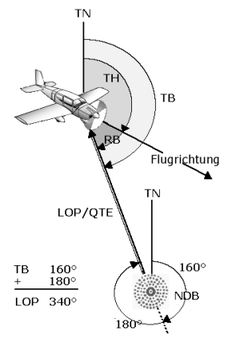Radio stand line
A radio aids (Engl. Radio line of position, LOP ) is a term used in radio navigation and describes the direction of an imaginary line from a ground transmitter ( Non-directional beacon / NDB) to your own point of view. The aircraft or ship is somewhere on this line at the time of the bearing.
In contrast to classic navigation, which calculates with correct courses, all courses in radio navigation refer to magnetic north ( MN). The radio station line (LOP) is therefore specified in the example as the angle between magnetic north and the direction from the NDB to the aircraft. This magnetic direction from the NDB to the aircraft or ship corresponds to the QDR in the international Q code .
In practice, radio lines are used to determine the location of the aircraft or ship ( position or fix ). The exact position of the aircraft or ship is somewhere on this LOP, so it cannot be determined by a single measurement. At least two LOPs are required for this.
The formula for calculating the LOP (QTE) is:
LOP = TB + 180 ° or
LOP = TB - 180 ° if the sum is more than 360 °
with TB angle between TN (true north) and direction to the beacon.
The instruments in the cockpit (ADF and VOR) indicate which magnetic base line (QDR) the aircraft is on. In order to enable a transfer to a map, because of its alignment to the true meridians, the location misalignment (English variation - the location-specific magnetic north pole) must be excluded. The true stand line then corresponds to the QTE.
See also
literature
- Peter Dogan: The instrument flight training manual as developed by Professional Instrument Courses, Inc. Aviation Book Co., Seattle WA 1999, ISBN 0-916413-26-8 .
- Wolfgang Kühr: The private pilot . Volume 4, A: Air Navigation . 2nd improved edition. Verlag Friedrich Schiffmann, Bergisch Gladbach 1979, ISBN 3-921270-05-7 .
- Jürgen Mies: Funknavigation , Motorbuch Verlag, Stuttgart 1995, ISBN 3-613-01648-6 , ( private pilot library 3).
- Jeppesen Sanderson (Ed.): Private pilot FAA practical test study guide. Airplane single-engine land . Jeppesen Sanderson, Englewood Col. 2000, ISBN 0-88487-265-3 .
- Jeppesen Sanderson (Ed.): Private Pilot Manual . Jeppesen Sanderson, Englewood Col. 2001, ISBN 0-88487-238-6 .
- Walter Air: CVFR textbook. Mariensiel 2001.
